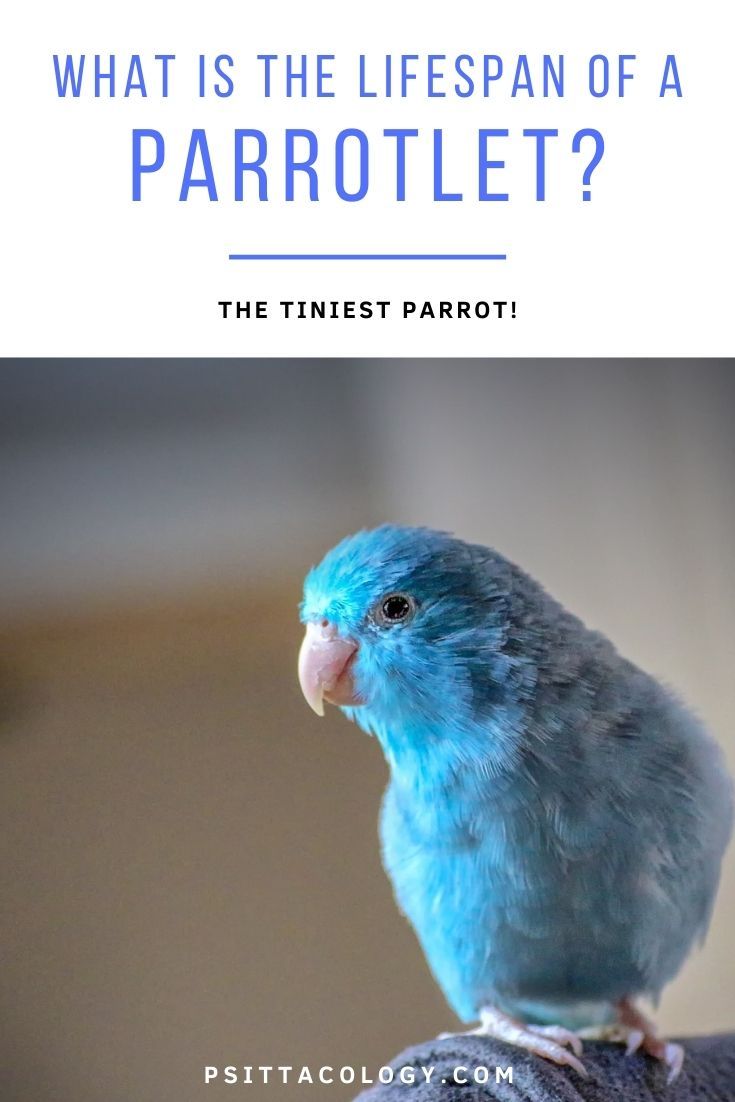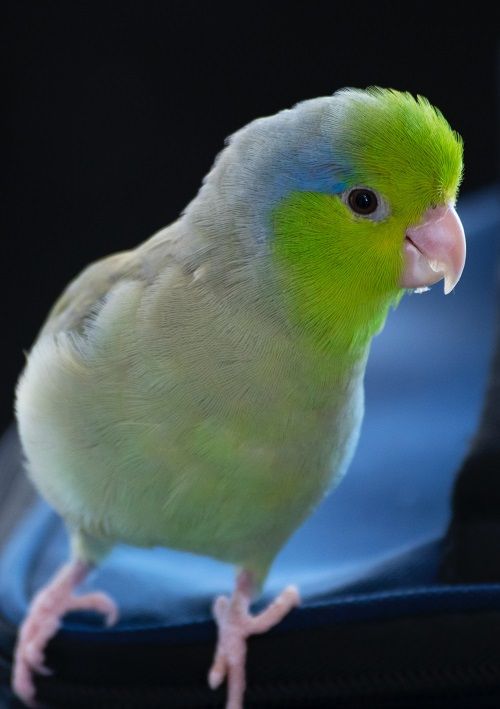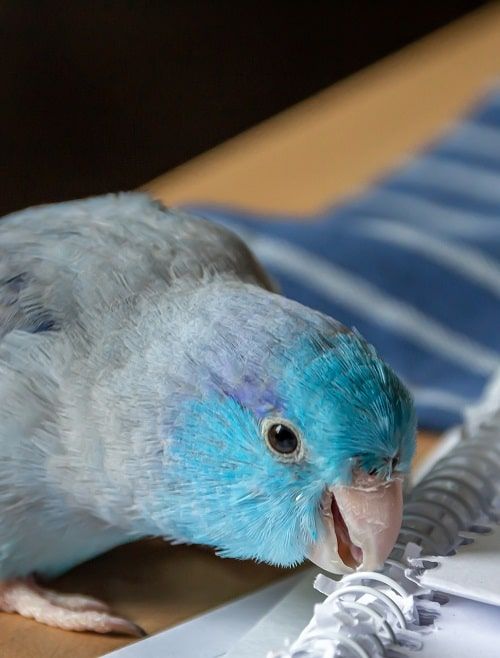If you’re thinking of adding one to your family, you might be wondering about the lifespan of a parrotlet. How long can you expect your tiny feathered friend to be around for? And what can you do to make sure it lives to a ripe old age?
Let’s go into the lifespan of a parrotlet and how to ensure yours lives a long and full life.
This post contains affiliate links. If you make a purchase, a small percentage will go directly to Psittacology at no additional cost to you. Thank you for supporting Psittacology!
Lifespan of a parrotlet in the wild
For the articles on parrot lifespan, I always try to dive into scientific records to find accurate numbers. Unfortunately, there is not that much available on the lifespan of a parrotlet in the wild.
The Encyclopedia of Life (EOL) consistently lists wild parrotlet lifespan as between 10.4-11.6 years. They define lifespan as the expected maximum age, but don’t list their source for this information.
Note: Parrotlets are comprised of three different genera: Forpus, Touit and Nannopsittaca. Forpus is the genus that you’ll see in captivity and which we’ll discuss here, as info on the lifespans of Touit and Nannopsittaca is pretty much impossible to find.

Lifespan of a parrotlet in captivity
You probably won’t be surprised to hear that most parrots (though not all; see Eclectus parrot lifespan) tend to live longer in captivity than in the wild.
Although their lifespan can be severely affected by a lack of knowledge about factors like diet, the fact that natural predators and other hardships are taken out of the equation definitely helps.
So how about the lifespan of a parrotlet in captivity? When it comes to captive parrot lifespan, one of the most extensive studies is called Survival on the Ark (Young, Hobson, Lackey & Wright, 2012). The authors analyzed birth and death records for a few dozen to 100+ specimens of a bunch of parrotlet species.
Here’s what they came up with for 6 parrotlet species:
| Species | Highest age recorded | Median adult age* |
| Mexican parrotlet Forpus cyanopygius | 12 years | 8.1 years |
| Green-rumped parrotlet Forpus passerinus | 11.6 years | 4.7 years |
| Blue-winged parrotlet Forpus xanthopterygius | 27.9 years | 9.1 years |
| Spectacled parrotlet** Forpus cospicillatus | 7.1 years | 7.1 years |
| Pacific parrotlet Forpus coelestis | 30.4 years | 6.1 years |
| Yellow-faced parrotlet Forpus xanthops | 10.5 years | 6.2 years |
** Only two of these were recorded, so take that with a grain of salt.
So what does this mean? Well, in short, you can definitely expect parrotlets to live for 5-10 years. We can assume that 10-15 years is attainable as well and parrotlets as old as 30.4 years old were actually recorded. This means you can get lucky and have a parrotlet live for 25+ years.
Of course, it’s important to keep in mind that more parrotlets need to be studied to ensure the accuracy of these numbers. Also, the parrotlets in the study lived in zoos and other organizations, so they were not kept at home. On the other hand, the researchers used official data, which is obviously more accurate than just asking parrotlet owners how old their undocumented bird is or was.

Lifespan of a parrotlet: What influences it?
We can talk about the lifespan of a parrotlet all we want, but it’s important not to forget that in the end, all this is potential lifespan. There is no guarantee your parrotlet will live to those coveted 30.4 years mentioned above.
That being said, there are things you can do to make this more probable. Disease and accidents can always happen, but at least with a good diet and stellar care your parrotlet has a shot of making it to an impressive age.
Let’s go into which main care factors affect parrotlet lifespan.
Diet & activity
This is where it goes wrong for so many pet parrots. Obesity and nutrient deficiencies are rampant issues due to lack of knowledge on diet and not letting birds out to exercise enough.
Don’t forget the following:
- Wild parrotlets are extremely active and can fly long distances daily. Our domestic birds will never reach this activity level, but let your parrotlet out of its cage for at least a few hours a day and encourage exercise with parrot toys. The cage should be as large as possible.
- Wild parrotlets eat a fruit-based diet, but fruits cultivated for human consumption are often too sugary. Additionally, captive parrotlets move around less, so they need fewer calories.
- A base diet of high-quality parrot pellets is usually the way to go. Supplement with fresh vegetables and, to a lesser degree, fruits. Don’t feed too many high-calorie seeds and consider sprouting them before feeding.
- Consider doing some further reading on parrot diet. A proper diet is crucial in keeping your parrotlet healthy in the long run!
Tip: You should weigh your parrotlet regularly. This helps you spot changes timely and ensure the bird isn’t too heavy or light. The ideal weight depends on the specific species.
Another factor you should pay attention to is how incredibly smart and social parrotlets are. If they’re awake, their little brains are in overdrive. They’re prey animals, so they naturally live in flocks to ensure safety in numbers.
In captivity, this means that:
- Lack of either mental stimulation or social interaction can cause severe stress in your parrotlet. Stress doesn’t just shorten parrotlet lifespan and make the bird more susceptible to disease, it can also cause unwanted behaviors like feather plucking, excessive screaming and aggression.
- Mental stimulation and social interaction obviously go hand in hand. If you interact with your parrotlet or provide a partner in crime for it to interact with, this keeps its brain busy as well.
- You can keep your parrotlet engaged with plenty of parrot toys and other items in the cage. Out of cage time to explore the house is also great, as is spending time together, especially training.
- For the social side, you should be around for most of the day to keep your parrotlet happy. If that’s not possible, it needs a cage mate (though make sure you have a large cage, as aggression occasionally happens in this species). You can play with, train and simply hang out with your parrotlet to help satisfy its social needs.
Tip: Make sure you’re aware of the symptoms of stress or illness in parrots. This allows you to hopefully spot issues before they get out of hand.

Safety
Once you’ve got the diet, interaction and enrichment parts down, you’re halfway there. However, there are some environmental factors to keep in mind, especially because parrots are so curious they can easily get themselves into trouble.
Some things to consider:
- Parrots have very sensitive lungs. Cigarette smoke, candles, cosmetics, air fresheners and even unexpected fumes like those from non-stick cookware can cause illness or even death. If it emits fumes, be sure to research whether it’s parrot-safe.
- Parrots are overly curious. Any space your bird has access to should be parrot-proofed. No running fans, no exposed heating elements, no toxic houseplants and more are all factors to keep in mind. And of course, no open windows or doors!
- Cage and toys should be safe. Inspect toys regularly for corrosion or broken parts. Avoid rope and fabric toys that can cause crop impaction or that your bird can get tangled up in.
- Have the number for an avian vet ready. Additionally, you can consider a small first aid kit with items like a blood clotting agent, disinfectant and tweezers.
How old is my parrotlet?
If you got your parrotlet from a breeder, you should usually know its exact hatch date from the accompanying documentation or a leg band. Things are a bit different with rescues and pet shop birds, where there is not always someone who can tell you how old the bird is.
Unfortunately, as with most other parrots, you can’t really tell how old a parrotlet is. Once they pass the juvenile stage and molt into their adult feathers, there isn’t any way to figure out their age.
Your parrotlet is a juvenile if it has a pink rather than skin-coloured beak. They’re also less colorful: in blue-rumped parrotlet, for example, the blue rump doesn’t show up until they’re a few months old.
If you have any more questions about the lifespan of a parrotlet or if you’d like to share your own experiences with these pocket-sized parrots, don’t hesitate to leave a comment below!
Sources
Young, A. M., Hobson, E. A., Lackey, L. B., & Wright, T. F. (2012). Survival on the ark: life‐history trends in captive parrots. Animal conservation, 15(1), 28-43.

Wish I’d found articles like this when I had birds. I swear there were ‘experts’ everywhere, one who said ‘a’ was perfectly fine, and another who said ‘a’ was deadly. So much of what I learned was pure luck mixed with a healthy dose of common sense. If it wasn’t ‘super’ healthy for me, I wouldn’t even consider it for my parrots. If I wouldn’t be overjoyed if my toddler would eat it, same deal. My birds ate better than any of us, and people called me crazy. But I had a 27 year old (when she finally passed away in her sleep) cockatiel, and other small birds who lived to be wonderfully ripe old ages. I love that you research and admit it’s not an exact science. Thank you for that. One silly thing I did I’d love to share… Underneath each if my small bird cages.. no newspaper.. instead a tray of growing wheat grass, changed weekly. Not right in the cage but growing underneath. The birds loved it growing up into their cages, especially my finches and ‘ tiels.
Parrotlets actually need quality seed in their diet along with vegetables. Pellets should only makeup a small percentage of their diet, although Tops is a good cold pressed pellets to look at and heat processed pellets should be avoided.
I do mention seed in the article, sprouted seed especially is great imo. I just don’t see how you end up not overfeeding them or causing malnutrition if you feed a seed-heavier diet. It’s impossible to achieve the level of variety they get in the wild with only dried seeds and they don’t move around nearly as much as wild birds, so obesity lurks. Feel free to share your insights, though, so folks can make their own informed decision upon reading all this.
So far my pacific parrotlet is almost 13 years old. She has some cloudiness in her eye and it seems like it makes it a little more difficult to land when flying but otherwise is in perfect health according to her avian vet. She’s always had a mix of zupreem and Harrison’s bird bread supplemented with fresh veggies and fruit (often also cooked into the bird bread), and a small amount of seed via nutriberries or avicakes. Sharing in case other owners are wondering how old their little loved one can get to. Also, she is blue from a green and a blue mated pair – in this way I ensured I would not be getting one with a lot of recessive genes that can make them more susceptible to illness (blues and other lighter dilute colors mated together will likely produce parrotlets with weakened systems. There’s a reason they mostly naturally occur as green and blue).
Thanks for sharing! I wish you guys many more happy years together 🙂
My 13 year old Parrott passed this morning..out of no where ..got up noticed she wasn’t acting right and 2 hours later Boggie died…I had 2 other ones that lived to 13 and one 16…I’ve owned over 25 parrotlets since 1996..I only have 3 left now
So sorry about Boggie. I hope you’ve concluded from this article that 13 is a respectable age for a parrotlet. I wish you many more happy years with the remaining trio.
My Nigel died this morning after being sick for 2 days. He was 12 and healthy until NYC was covered in toxic smoke from Canadian wildfires. Even with windows closed and air purifier running constantly, Nigel still got sick. I am heartbroken. He was my little cowboy and a big part of my life.
Hey Toni. I’m so sorry about Nigel. I’ve read many posts by desperate parrot owners trying to figure out what to do to keep their birds healthy until the smoke dissipates. Looks like you did everything possible, but they’re just so, so sensitive. I’ve got nothing else to add; rest easy cowboy!
I had my parrotlett for 17 years (Dec 2005) He got sick a few ago after passing out with breathing issues, he passed on. Great little bird with many years of life, talking and personality.Vet said they had not heard of one this old. Love and care exceeds any life expectancy.
Sorry for your loss. I agree that’s a very respectable age! Thanks for sharing 🙂
I was always a bit afraid of birds but when my mother in-law wasn’t able to take care of her 15 year old parrolett anymore my heart broke for him and I offered to make his last days happy ones. That’s now over a year ago. He’s now well over 16 and seems to always be glued to my shoulder either sleeping or chatting away. Doesn’t fly much as he isnt very good at it. Dr. Says he’s healthy. I have to admit I’ll miss my little broach, as everyone calls him, when his time comes. And I wonder why I was ever afraid of birds.
Good on you for taking him in and discovering birds aren’t so bad 🙂 I hope you guys can enjoy many more happy years together.